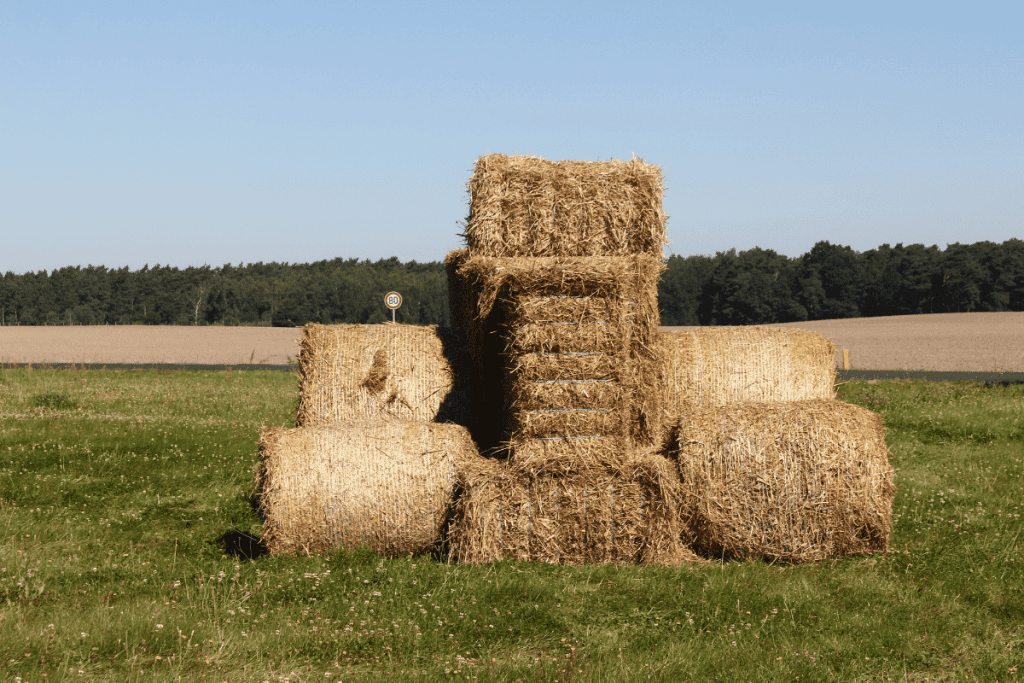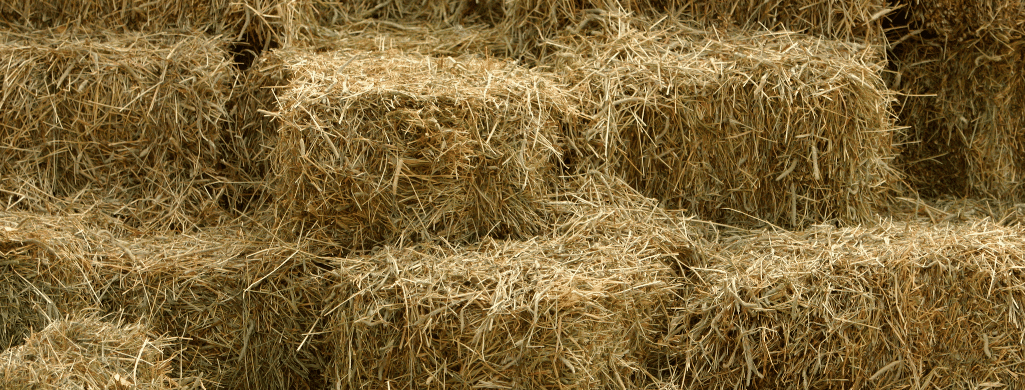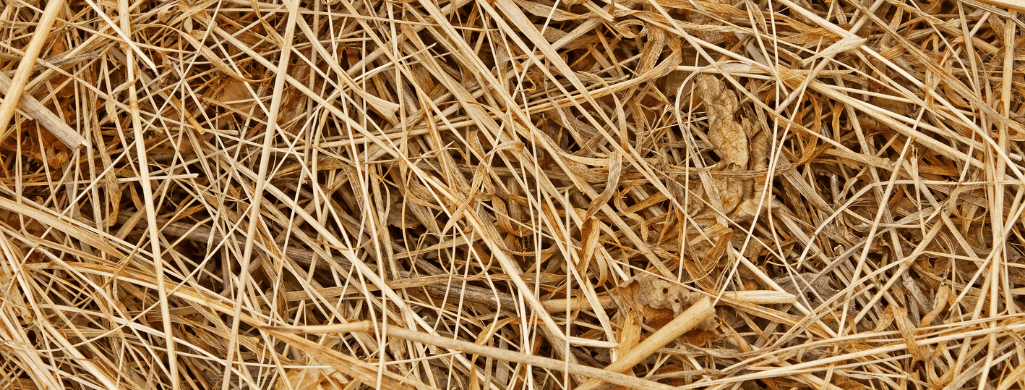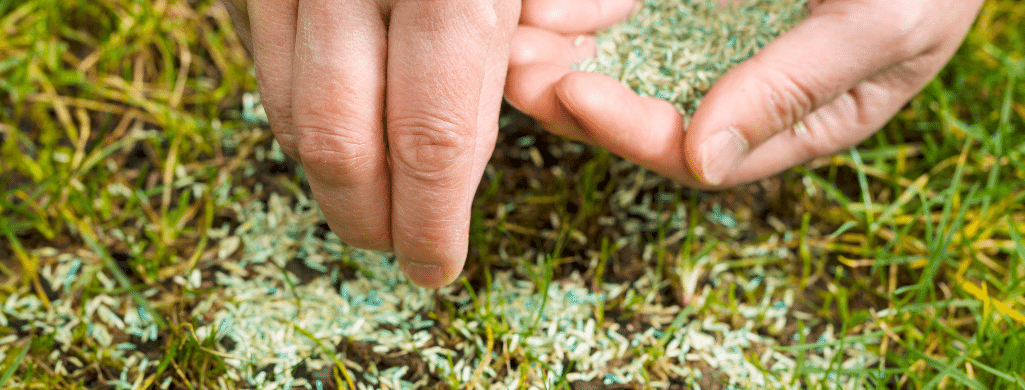If you’ve ever seen straw or hay lying across someone’s yard and wondered what its purpose was, chances are, they’ve recently planted new grass seed.
But why should you leave hay on newly-planted seeds, how long should you leave it, and what do you do next?
Leave hay on grass seed until the grass has reached around 2 to 3″ inches in height. This helps prevent the fragile seeds from washing away in heavy rain and winds and keeps animals from eating them, and once the straw breaks down, it provides nutrients to the soil.
Keep reading to learn more about placing hay on top of grass seed.
We’ll go more in-depth into why this unusual practice is so beneficial for new seeds, what to do with the hay once the grass has grown, and any other questions you probably have.

Table of Contents
Why Should You Put Hay On Grass Seed?
The main reason you put hay on grass seed is to protect it from environmental damage and prevent animals from digging them up and eating them. Additionally, over time, the hay will decompose, which will provide the new seeds with a quick nutrient boost.
As far as environmental damage goes, hay provides a lot of protection from various natural stressors.
The most obvious is heavy rain and wind, which newly-planted grass seed is highly prone to in the first few weeks of its life cycle.
By placing a thin layer of straw or hay on top of the seed, you’ll be able to easily prevent it from eroding and washing away even in the harshest storms.
This is particularly useful if you’ve planted the seed on a slope, hill, or in poor soils where heavy erosion is expected.
Additionally, sun damage is another issue with freshly planted grass seed.
This is especially true if you live in a sweltering area with dry weather.
As the harsh sun bears down on the seeds, it evaporates any water in the soil very quickly, resulting in dry, damaged seeds, some of which will refuse to grow if the damage is too extensive.
A layer of hay also helps preserve moisture and prevent root rot for longer after you’ve watered the fresh seeds.
Generally, you’ll need to water new grass seed twice daily, making sure you have moist soil at all times until seed germination takes place.
However, if you don’t water it at the right time (ideally once early in the morning and again early in the evening before the sun sets), you risk the water evaporating within minutes and wasting the moisture the soil, and your seeds need to thrive.
Even the most drought-resistant grasses are prone to this, and it’s one of the reasons why watering at a particular time of day is so essential to healthy growth.
Finally, the hay will deter animals, family members, and neighbors from damaging the seeds.
The hay will insulate the seeds and make them more difficult for birds, squirrels, and other typical garden and lawn pests to dig up and run off with.
It will also clearly mark the area to other people in your yard, so they don’t accidentally walk on and damage the new seeds.

What’s The Difference Between Hay And Straw?
While hay and straw are good to prevent new grass seeds from washing away or becoming damaged, they have a few key differences. The main difference is hay is fresh plant cuttings containing seeds of whatever plant was cut down, while straw is dried plant stalks with no seeds.
Overall, hay and straw are both acceptable to use to protect your newly-planted grass seeds.
However, straw makes much better mulch than hay since it doesn’t contain any seeds.
You won’t have to worry about the miscellaneous seeds potentially sprouting like you would with hay.
If you’re not concerned with using it as mulch and simply want to coat your new grass seeds to protect them for a short time, it’s safe to use hay or straw interchangeably.
Both will hold moisture and break down over time, providing a nutrient boost and ensuring bright, green leaves of grass once the protective barrier is no longer needed.
This also means you won’t need to remove it once the grass begins to sprout; just leave it for the seeds to feed on.
If you want some additional tips, check out our post on protecting grass seed from heavy rain.

How Long To Leave Hay On New Grass Seed
Leave a thin layer of hay on your grass seeds until the grass reaches around 2 to 3″ inches tall. The exact amount of time will vary depending on various factors such as the weather and soil conditions and the type of grass used, but generally, expect to wait anywhere from 2 to 6 weeks.
It’s difficult to estimate precisely how long you’ll need to leave the light layer of hay on top of your newly-planted grass seeds, as there’s an extensive range of factors that will influence the growth rate of the seeds.
Some of these factors include:
- The type of grass seed you’ve planted
- Whether the grass seed is the correct type for your climate zone
- Whether the grass seed is annual or perennial
- How heavy the rainfall is in your area
- The type of soil you’ve planted the seeds in; for example, rocky soils and coarse soils usually take more time for seeds to germinate properly
- The time of year, i.e., whether you’ve planted the grass in late summer versus late spring or mid-summer
- How drought tolerant the type of grass you’ve planted is
- The temperatures and temperature fluctuations in your area
- Whether or not you’ve used fertilizer
- The overall health and quality of the soil you’ve planted the seeds in
This seems like a long list, but these are just a few of the conditions which affect how fast grass seed grows and, in turn, how long you’ll need to leave the hay on top.
The amount of time you’ll need to leave the hay on the seeds will potentially range from as little as two weeks to as long as a month and a half.
Regardless of how long you end up waiting, though, it’s highly recommended to leave the hay on the grass at least until it has sprouted and the grass blades have reached 2 to 3″ inches tall.
Be patient, as it takes a bit of time even for the fastest-growing grasses to penetrate several inches of soil.
By this point, the seed heads will have established relatively solid and sturdy roots and can stay in one place even during strong winds and rain, and most animals will leave the grass alone since they won’t be able to dig up the seeds anymore.
Even more fragile ornamental grasses with narrow leaves will be pretty sturdy at this point.
You also won’t need to mark the area for family members and neighbors because the grass should be strong enough to withstand foot traffic at this point.
Check out our related article on how long it takes grass seed to fully grow.

What To Do With Hay After Grass Grows
It’s best to leave the hay on the new grass seed until the grass is strong enough for its first mowing. Over time, much of the hay will decompose, giving the seeds the nutrients it needs to thrive. After you’ve mowed the new grass, either remove the leftover hay or simply leave it to break down further.
You don’t have to ever remove the hay at all if you don’t mind how it looks on your lawn.
However, some people opt to remove the leftover hay after mowing the new grass for the first time.
This is mainly for aesthetic purposes, as the partially decomposed, yellowing hay doesn’t look particularly significant if you want a pristine, beautiful lawn.
If you plan to remove the hay as soon as possible, you need to wait until after the first time you mow the new grass.
You’ll be able to mow it for the first time once the leaves of grass have grown to at least 3″ inches in height.
This way, the grass will have gotten as many nutrients as possible out of the decomposing hay, and you won’t risk prematurely disturbing the seeds and potentially digging them up.
Again, we strongly recommend simply leaving the hay on the grass indefinitely.
It will fully break down within a few weeks or so anyway.
The nutrients present in the hay will strengthen the grass significantly in the long run, making it less prone to environmental damage, lawn diseases, and damage from foot traffic.
It’ll also protect the fragile seeds in the meantime while they’re busy growing to a mow-able height.

Will Grass Seed Grow Without Straw/Hay?
Grass seed will grow without a layer of hay or straw on top, but it will be far more prone to erosion, various types of environmental damage, and damage from animals digging the seeds up and eating them. Your new grass will also miss out on the many essential nutrients present in the hay.
Overall, we highly recommend you place a thin layer of hay on top of any new grass seeds you’ve planted, regardless of the type or season.
It’s a simple, inexpensive task, and it isn’t particularly time-consuming, so the many benefits make the small amount of effort involved well worth it.
This is especially true if you’re planting new grass seed on a slope or a hill.
The hay, in this case, is not only recommended but necessary to prevent the seeds from sliding out of place and eroding in heavy rain.
In addition, if you live in an area where you commonly deal with garden pests like squirrels or certain insects, the hay will discourage the animals from undoing all of your hard work.
Table of Germination Rates For Common Lawn Grasses
The following table shows the average germination rates for several common grass species in ideal conditions.
Understanding how long it takes for your grass seeds to germinate will help you plan when to start a regular fertilizer schedule and mow your new lawn.
| Grass Type | Average Grass Seed Germination Rate |
|---|---|
| Annual Ryegrass | 5-10 days |
| Bermuda Grass | 10-28 days |
| Centipede Grass | 14-21 days |
| Kentucky Bluegrass | 14-28 days |
| Perennial Ryegrass | 5-10 days |
| Tall Fescue | 7-12 days |
| Zoysia | 14-21 days |
Alternatives To Use Instead of Hay on Grass Seed
If you are worried about seeds or herbicides found in hay, there are several organic alternatives to cover your grass seeds.
Any type of mulch you are able to apply in a thin layer will protect your seedlings from the elements and retain moisture.
Some alternative grass seed coverings are better than others.
Avoid bark mulch, as it is too heavy, and the grass seedlings may be suffocated.
Fresh pine straw should also be avoided because it releases toxic chemicals known as terpenes.
Old pine straw may be used cautiously since most of the terpenes will have evaporated from it.
If the pine straw has a strong smell, it still contains terpenes.
Take care when using manure composts, as the livestock may have ingested herbicides.
The herbicides will remain in the manure for up to four years after the hot composting process.
Sawdust Mulch
Sawdust mulch works well as a cover for grass seed as long as it is applied in a thin layer.
If sawdust mulch is too thick, it will become matted and prevent your seedlings from germinating.
The layer of sawdust only needs to be about a quarter of an inch thick.
Be careful not to overwater your grass seeds when using sawdust as a covering.
The small sawdust particles may form a barrier, causing slow evaporation.
Excessive water in the soil will cause damage to the developing grass roots.
You must also pair a fertilizer with sawdust mulch because it will leech nitrogen from the soil.
Peat Moss
Peat moss is often used to help the soil retain nutrients, although it does not contain any nutritional value on its own.
It is crucial to apply peat moss properly because it will make your soil more acidic.
Before using it to cover your grass seedlings, the peat moss must be loosened by hand.
Spreading the peat moss in a thin layer will protect your newly-planted grass seeds and prevent the evaporation of water from the soil.
Applying peat moss without loosening it up first will cause it to soak up moisture and create dry soil.
While peat moss is not the best choice for covering grass seeds, it offers effective protection when applied correctly.
If you use peat moss to cover your grass seeds, it is crucial to monitor your soil’s pH and moisture levels.
Compost
Leaf compost and mushroom compost are both excellent alternatives to using hay when covering grass seedlings.
Both types of compost contain an excellent blend of nutrients to encourage germination and healthy grass growth.
As the compost decomposes, it creates an organic nitrogen-rich fertilizer.
You only need to apply a ¼”-inch layer of compost over your grass seeds to protect them and retain moisture.
Always ensure the compost is almost fully decomposed before applying it to your lawn.
Organic matter which has not decomposed will attract birds and other wildlife who will eat your newly-planted grass seeds.